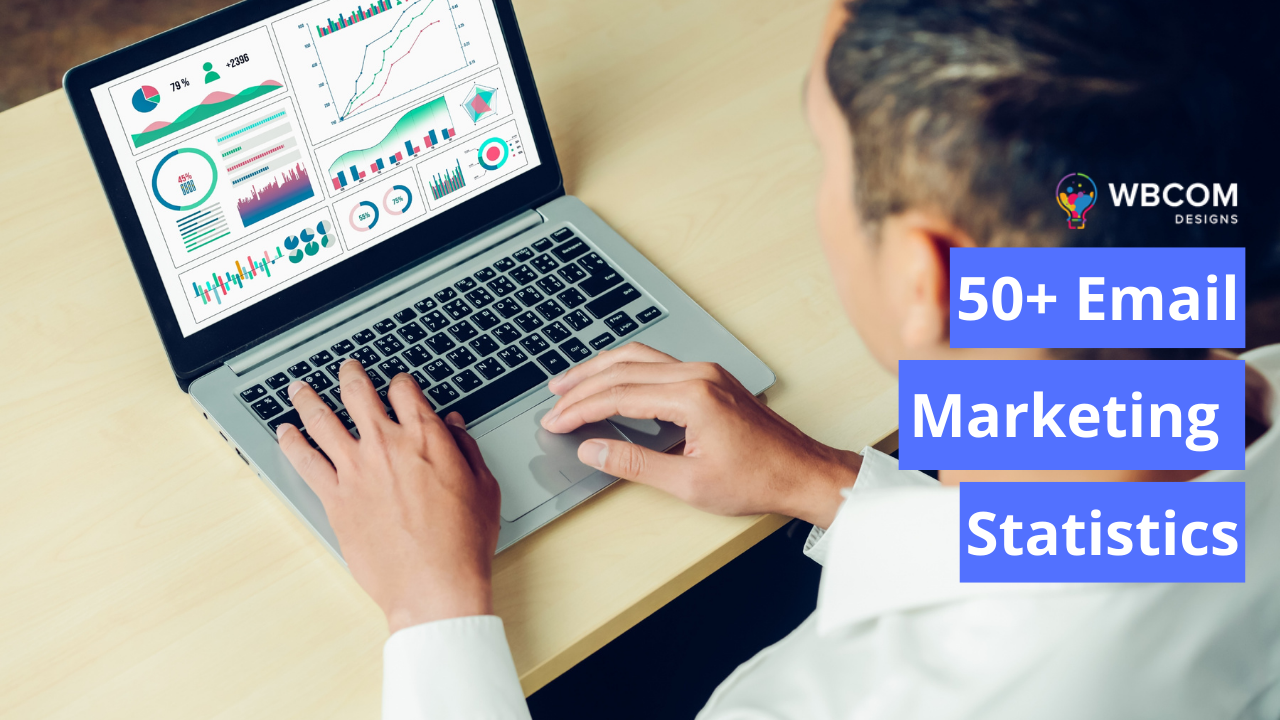Businesses of all stripes would be wise to put money into email marketing. In case you still need convincing that your email marketing efforts will pay off, we’ve assembled a massive set of statistics on email marketing that will astound you.
Newer marketing methods to reach their target audiences include webinars, video campaigns, and social media posts. Email marketing is one of the oldest and most powerful tools, but don’t let that make you forget about more modern forms of communication. The return on investment (ROI) for email marketing is $36 for every $1 invested.
Table of Contents
ToggleIs Email Marketing Overrated?

Every year, the efficacy of email as a marketing tool is questioned. Even so, the data reveal that it is more robust than ever.
- In 2020, people worldwide sent and received 306.4 billion emails daily.
- Email is the critical lead generation method for 89% of marketers.
- The average clickthrough rate for an email is 10.69%, while 22% of marketers say theirs is more than 20%.
- In 2020, the average rate of cancellation was 1%.
- Spam incidence rates averaged 0.02% for all of 2019.
- The median percentage of opening emails in 2020 was 18%.
- Meanwhile, the average click-to-open rate was 14.1%.
- An average of 0.7% of visitors were bounced.
- Aiming for a 10% response rate is reasonable.
- Over 86% of working professionals prefer communicating via email.
- Email marketing has a 77.6% adoption rate throughout EMEA, N.A., and APAC, while content management and social media each account for a 62% share.
- Email marketing is seen as the most successful marketing method by 29% of professionals in the field, followed by social media (25%), search engine optimization (22%), and content marketing (25%).
- Ninety-three percent of B2B content marketers utilize email as a distribution medium.
- Email is the most popular method of company contact, chosen by 72% of consumers.
- Of those who participated in the survey, 52% responded that email is their primary means of contact.
Also Read: Top 7 Crucial Reasons To Use Structured Data For SEO
Importance Of Email Marketing In 2022
In that case, why does it seem to work so well? A positive return on investment may be expected from email marketing. It’s versatile and changes into several forms! Evidence from the numbers:
- In the first hour after delivery, 21% of emails are opened.
- The Return On Investment (ROI) for email marketing is $42.00 ($42.00 for every $1.00 invested).
- The conversion rate for emails is 40% higher (in comparison to Facebook and Twitter).
- Forty percent of B2B marketers say email newsletters are the most crucial part of their content marketing strategy.
- While just 13% of respondents mentioned websites and only 11% named social media, 37% of respondents chose email as the most effective medium for client loyalty and retention.
- Fifty-seven percent of consumers say they are swayed to purchase because of marketing and promotional emails.
- Most commonly, email marketing is used to increase sales (84%), generate new leads (78%), nurture existing leads (81%), and retain existing customers (74%).
Email Frequency And Timing

Knowing the optimal moment to send an email can increase conversion rates. Additionally, data from email marketing can provide light on the optimal email-sending frequency and time.
- 61% of subscribers/customers want weekly promotional emails, and 38 percent want them more often.
- Two to three times (32%), four to six times (19%), once (17%), and six times or more (16%) are the monthly rates at which marketers contact their clientele.
- Around a quarter of subscribers (30%) say they want promotional offers sent to them more frequently than once a week.
- More emails are sent on Thursdays (18%) than any other day of the week (17% on Tuesdays and 16% on Wednesdays).
- In general, weekend open and clickthrough rates are lower.
- The highest clickthrough rate for emails is around midnight, and the ideal time to send emails is 11 a.m.
- Primarily, people travel in the fall and winter (especially on Black Friday, Cyber Monday, and December 23).
- There is no ideal time to send email marketing, say half of all marketers because each customer and company is different.
- Tuesdays and Thursdays are the most productive for sending emails.
Also Read: Tutor LMS Review: Is this Plugin Worth it in 2023?
Email Sending Automation
This 2022 report on the state of email marketing automation should convince everyone who didn’t utilize it in 2021 to reconsider. Why? Said, it’s a more efficient use of your resources that will net you more sales.
- 51% of businesses use some form of automation presently.
- 64% of B2B respondents report using automated email systems.
- The most notable gains from using marketing automation are:
- Saving time (30%)
- Lead generation (22%)
- Higher revenue (17%)
- Customer retention (11%)
- Monitoring marketing campaigns (8%)
- Shortening the sales cycle (2%)
- Only 47% of marketers think automation is genuinely cost-effective.
- 68% of respondents think that automated message targeting is better.
- Eight times as many people open trigger emails as regular bulk emails, and sales are higher for trigger emails.
- Average spam and unsubscribe rates for automated emails are 0.06% and 0.58%, respectively.
- Automation is most effective when combined with customer journey mapping (53%) and tailored messaging (51%).
- All kinds of emails may be sent with the help of automation software:
- Welcome emails (47%)
- Promotional sales emails (46%)
- Transactional emails (28%)
- Invitations and reminders (27%)
- Blog updates (26%)
- Upselling emails (23%)
- Event-triggered emails based on customer lifecycle (15%), etc.
- The average clickthrough rate (CTR) for automated email campaigns is 11%, while the average open rate is 46%.
Also Read: 8 Best Recruiting Tools For Recruiters
Segmentation And Personalization
Personalization is the most effective way to increase your email campaigns’ open rates and clickthrough rates. Make the recipient of your email feel like they’re part of a select group at all times by segmenting your lists and adding personal touches.
- In 2021, the most successful email techniques were list segmentation and customization.
- Click-through rates for focused email marketing are 50% higher than for non-targeted ones.
- An increased open rate (82%), clickthrough rate (75%), and happy customer base (58%). These are the top three benefits of employing customization in email marketing.
- List segmentation (51%), customization (50%), and triggered emails (45%) are the top three most popular methods of email marketing.
- An experiment conducted by SuperOffice found that a segmented email campaign had a 94% open rate and a 38% CTR. In comparison, a non-segmented email campaign only had a 42% open rate and a 4.5% CTR.
- Using specialized advertising, marketers may see a return on investment of 760%.
- According to a recent survey, users are more likely to respond positively to an email if they believe it was designed with them in mind.
- When an email’s subject line is tailored to the recipient, 62% more of them will click on it.
- Using the recipient’s name can boost open and clickthrough rates by as much as 35%.
- 10% say they get frustrated by the lack of personalization or if they aren’t given enough options.
- Consumers find it most annoying when brands propose products that don’t interest them (34%) when deals expire (24%), when names are misspelled (15%), when promotions are timed poorly (14%) or when they have already made a purchase (13%).
- While some 31% of marketers say they employ basic segmentation (2-5 criteria), only 4% engage in highly specialized targeting, and 53% don’t target.
- Email marketing campaigns that use segmentation and personalization drive 58% of sales.
- Many marketers (62%) believe customization is the most successful strategy.
- There was a 39% increase in open rates for segmented email marketing and a gain of 24% in revenue, 24% in deliverability, and 18% in sales leads and transactions.
- An email’s three most essential parts are the subject line, the body, and the closing.
- What determines whether or not a receiver converts is the quality of the email you send them, including the subject line and closing. Take advantage of these essential email facts to formulate the ideal approach.
- About half of recipients choose an email only based on the subject line, and nearly as many consumers (69%) report messages as spam based on that one field.
- One research found that emails without subject lines were so fascinating that their open rate was 8% higher.
- Compared to other promotional emails, the average income per welcome email is 320% higher.
- Emails with longer subject lines have a higher open rate.
- 6-10 words (21%),
- 0-5 words (16%)
- 11-15 words (14%)
- 16-20 words (12%)
- There is a 17% drop in open rates for emails containing the word “fw:” in the subject line.
- The open rate of an email is increased by 22% if the subject line is personalized.
- The most common items in an email’s subject line are:
- The customer’s name (46.21%)
- The product name/details (44.01%)
- The company name (42.88%).
- Concurrently, the highest email marketing conversion rate (3.71%, 3.18%, and 3.58% correspondingly) is found in these three variables in the email subject line.
- Eight times as many purchases are made from emails, including promo codes, as from those without.
- The typical marketing email has 434.48 words and 3.3 minutes to read.
- Emails between 150 and 200 words long get the most responses (19%), followed by shorter ones (50-100 words) (17%) and longer ones (150-250 words) (15%) from subscribers.
- The iPhone truncates subject lines of more than 32 characters.
- Half of all managers routinely sign off on their messages with an email signature.
- There is a 32% increase in responses to emails with a photo signature compared to those without.
- Most email senders (75%) provide contact information, with 60% including a phone number, and fewer yet (7%), Twitter (3%), Facebook (2%), and LinkedIn (2%), attaching these social media accounts.
- Regarding email, 17% of individuals are using a formal tone, 33% are using an informal tone, and 49% don’t know.
- The most commonly used farewells are:
- Thanks (62%),
- Name or initials (46%)
- Sincerely (44%)
- Love (28%)
- Regards (22%)
- We did enable responders to select more than one option, though.
- The least irritating closing is “Thanks” (only 3% detest it), while the most obnoxious is “Peace” (21% despise it).
- 40% of respondents said they’d prefer not to get promotional emails and only receive those that are useful to them.
Visual Content In Email Campaigns
In this day and age, emails can contain both text and images. Utilize more visuals in your campaign to spice things up. Don’t be afraid to deviate from the norm; 45% of consumers say they “like brands that do not take themselves too seriously.” Consider using emojis, videos, and images in your next email marketing campaign after reading this valuable data.
Emojis
Email marketers are strongly divided on using emojis in their messages. The efficacy of emails using emojis has been debated, with some pointing to statistics that seem to disprove this theory. But it’s not relatively as easy as it seems.
- While 68 percent of millennials report using and enjoying the presence of emojis, GIFs, and stickers in email, only 37 percent of those 65 and older feel the same way.
- The clickthrough rate for emails using an emoji in the subject line is 56% higher.
- Emojis are more prevalent among female recipients than male ones.
- In a poll, emojis were used by 76% of respondents at least once in a professional email.
- The complaint rate during holiday marketing may be reduced to zero using the right emojis.
Videos
What occurs when the video is included in an email? This data assemblage on email marketing will reveal all, demonstrating how including videos in your strategy may be the best next step for your campaign.
- Including a video in the first email boosts the clickthrough rate by 96%.
- To promote their products, 81% of marketers utilize videos.
- In terms of return on investment, video marketing is overwhelmingly popular, with 78% approval.
- Including a video in your email may raise the clickthrough rate by 200-300%.
- The term “video” boosts open rates by 19 percent, clickthrough rates by 65 percent, and subscription cancellations by 26 percent.
- Emails, including videos, are more popular with subscribers (54%).
- The vast majority of viewers (84%) prefer watching movies on a computer, while only 14% prefer doing so on a mobile device.
- 90% of consumers report that seeing product videos influences their final buying decision.
Pics
The information included within an email is significant. However, how an email is presented is not always secondary. According to the data on email marketing below, visual content will still be important in 2022.
- Two-thirds of respondents to the study said they would rather receive emails with lots of pictures than plain text.
- Both the open rate (27%) and clickthrough rate (4.5%) of graphic-rich emails are greater than those of text-only emails (20% and 3%, respectively).
- If a message isn’t opened within 5 seconds, 74% of recipients will delete it (most likely because of the size of the pictures in the email).
- As many as 43% of email recipients don’t view the photos.
- Sending emails with a 4:1 text-to-image ratio is optimal for readability.
Desktop And Mobile Optimization

Marketers often overlook the necessity of mobile optimization. These email marketing statistics show how important it is to have a mobile-friendly email marketing strategy.
- While 74 percent use a computer, 21 percent use a tablet, and 2 percent use a wristwatch, 81 percent check their email on a mobile device.
- Nearly 90% of smartphone owners regularly read their email on the go.
- Almost 20% of all email campaigns were not mobile-friendly.
- If an email is not mobile-friendly, 42.3% of recipients will trash it, while 32.2% will wait to view it on a desktop.
- If the message doesn’t seem right on the screen, the recipient will delete it 70% of the time.
- Over half (52%) of B2C companies still don’t optimize their emails and websites for mobile use.
- It’s been shown that consumers are less likely to share if a mobile site isn’t easy to navigate.
- Between May and June of this year, over half (46%) of all emails were opened on mobile devices, while just 18% were opened on desktop computers.
- Most (88%) smartphone owners check their email on the go.
- One-third of all professionals now check their emails on the go.
- Apple’s iPhone and Google’s Gmail are the two most widely used email clients, accounting for 34% and 26% of openings, respectively.
- 75% of all Gmail users now check their inboxes on their phones or other mobile devices.
- There are ten times as many takers for a mobile coupon as a printable one.
Conclusion On Email Marketing Statistics
The availability of these numbers will undoubtedly provide credence to your lead generation efforts. In the future, if you need a reliable collection of email marketing data, you may come back to this piece.
It’s time to put these numbers to work in your lead-generation campaigns. Our Email Drip Campaigns feature allows you to keep tabs on your contacts, schedule emails to be sent at specific times, automatically follow up with them, divide your contacts into groups, customize your communications with them, and more.
Interesting Reads:
How to Advertise Your E-commerce Business Online
How To Set Up WordPress For Amazon SES? Complete Guide To Follow






